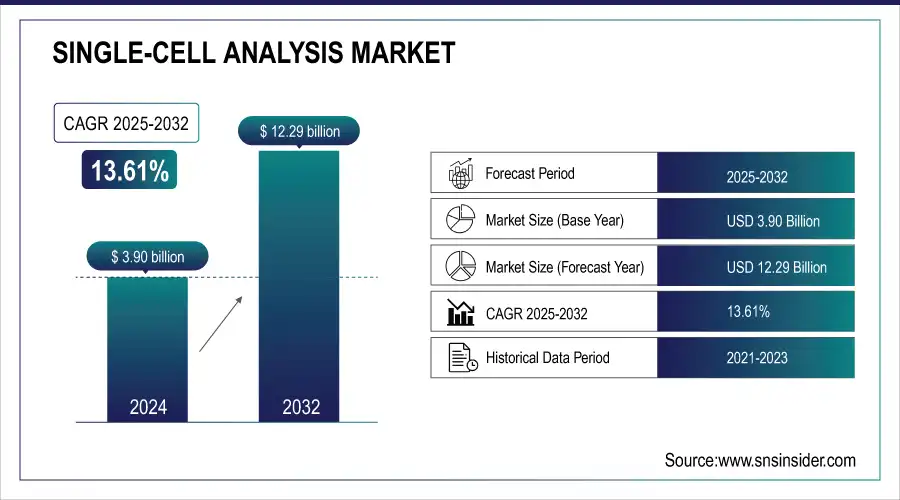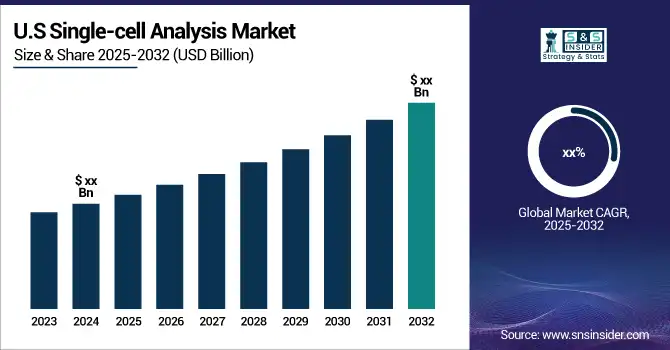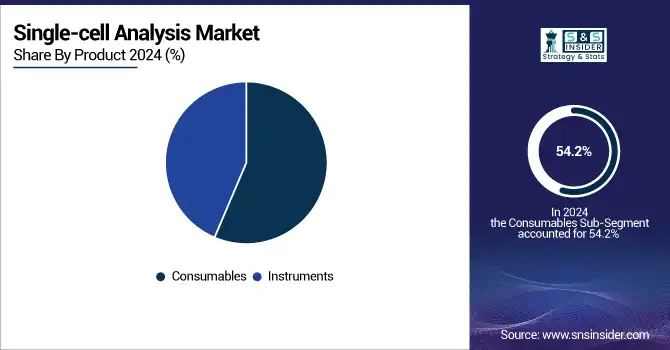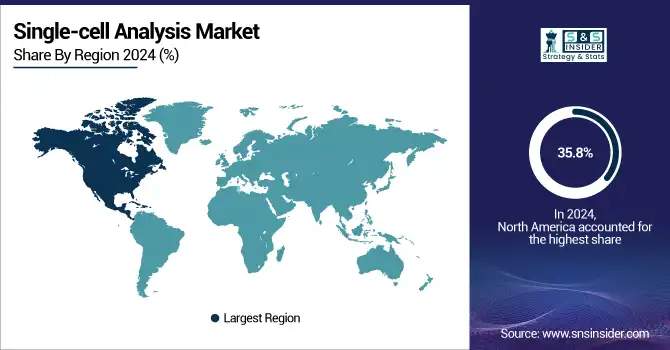Single-cell Analysis Market Report Scope & Overview:
The Single-cell Analysis Market was valued at USD 3.90 billion in 2024 and is expected to reach USD 12.29 billion by 2032, growing at a CAGR of 13.61% from 2025-2032.
The Single-cell Analysis Market is expanding due to increasing demand for precision medicine, biomarker discovery, and advanced diagnostic applications. Rising adoption of single-cell technologies in cancer research, immunology, and genomics enables deeper understanding of cellular heterogeneity. Technological advancements in high-throughput sequencing, microfluidics, and bioinformatics are enhancing analytical accuracy and efficiency. Additionally, growing research funding, increasing pharmaceutical and biotechnology investments, and rising awareness of personalized healthcare solutions are driving widespread adoption, fueling robust market growth globally across research and clinical applications.
Market Size and Forecast
-
Market Size in 2024: USD 3.90 Billion
-
Market Size by 2032: USD 12.29 Billion
-
CAGR: 13.61% from 2025 to 2032
-
Base Year: 2024
-
Forecast Period: 2025–2032
-
Historical Data: 2021–2023

Get More Information on Single-cell Analysis Market - Request Sample Report
Single-cell Analysis Market Trends
-
Rising demand for precision medicine and genomics research is driving the single-cell analysis market.
-
Growing applications in cancer research, immunology, and stem cell studies are boosting market growth.
-
Advancements in microfluidics, next-generation sequencing, and imaging technologies are enhancing analysis accuracy and throughput.
-
Expansion of biopharmaceutical R&D and personalized therapy development is fueling adoption.
-
Increasing focus on understanding cellular heterogeneity and biomarker discovery is shaping research trends.
-
Integration with bioinformatics and AI-driven data analysis is improving insights and decision-making.
-
Collaborations between research institutions, biotechnology companies, and instrument manufacturers are accelerating innovation and commercialization.

Single-cell Analysis Market Growth Drivers:
-
Increasing Adoption of Single-cell Technologies in Cancer Research and Precision Medicine is Boosting Market Demand Globally Across Multiple Applications
Rising adoption of single-cell analysis in cancer research, immunology, and genomics is accelerating demand. These technologies enable precise biomarker identification, early disease detection, and personalized treatment strategies. Pharmaceutical and biotechnology companies increasingly invest in single-cell platforms for drug development, mechanism studies, and cellular heterogeneity analysis. Technological advancements in microfluidics, high-throughput sequencing, and imaging are enhancing efficiency and accuracy. The growing need for precision medicine and advanced diagnostics, coupled with increasing research funding and collaborations, is significantly driving the expansion of the Single-cell Analysis Market globally.
Single-cell Analysis Market Restraints:
-
Complexity of Data Analysis and Requirement of Skilled Personnel Hinders Efficient Utilization of Single-cell Analysis Technologies
Single-cell analysis generates massive datasets requiring advanced bioinformatics tools and statistical expertise for accurate interpretation. Lack of skilled computational biologists and trained personnel can lead to delays, errors, and misinterpretation of results. Laboratories must invest in training or hire specialized staff, increasing operational costs. Additionally, data storage, integration, and standardization challenges limit seamless utilization of multi-omics single-cell datasets. Complexity in handling diverse experimental workflows, coupled with insufficient automation, discourages adoption in smaller labs. These technical and personnel barriers act as significant restraints, slowing the full-scale adoption of Single-cell Analysis technologies globally.
Single-cell Analysis Market Opportunities:
-
Growing Adoption of Single-cell Analysis in Clinical Diagnostics and Precision Medicine Presents Significant Revenue Generation Potential Globally
Single-cell technologies are increasingly used in early disease detection, prognosis, and patient stratification for personalized treatment. Hospitals and diagnostic centers are adopting these platforms for oncology, infectious diseases, and genetic disorder testing. Regulatory support and clinical validation of single-cell assays are further encouraging implementation. Integration with AI, machine learning, and automated workflows improves diagnostic accuracy and operational efficiency. Rising awareness among clinicians and patients about precision medicine benefits is driving adoption. These trends present substantial opportunities for vendors to expand product offerings and capture revenue in both clinical and research segments worldwide.
Single-cell Analysis Market Segment Analysis
By Product, Consumables segment dominated in 2024; driven by high demand for isolation products, beads, buffers, and assay kits.
In 2024, the Consumables segment is expected to hold the highest market share of 54.2% in during the forecast period due to high usage of isolation products, cell sorting beads are widely used, buffers and reWorkflows are frequently purchased, and there is an increasing need for assay kits. The rise in the incidence of the target disorders and the ongoing need for the supplies needed for the tests during research activities are propelling the segment's expansion.

By Workflow, Single Cell Isolation & Library Preparation segment led in 2024; growth supported by diverse isolation products and expanding SCA applications.
In 2024, Single Cell Isolation & Library Preparation segment is expected to dominate the market share of 37.5% during the forecast period due to the need for kits and reWorkflows for cell isolation and library preparation has risen as a result of the wide range of SCA applications. Additionally, a sizable number of market participants are providing a variety of single-cell isolation products, including, to name a few, FACS and MACS for heterogeneous cell suspensions, microdissection of fixed tissue samples, flow cytometry, and microfluidics. This is helping this market segment grow in terms of revenue.
By Application, Cancer segment dominated and projected fastest growth in 2024; driven by rising incidence, genetic variation analysis, and ongoing research
In 2024, the Cancer segment is expected to dominate the market share of 33.2% and also expected to be the fastest-growing segment of the market with a CAGR of 19.87% during the forecast period. For accurately identifying cancer cells, single-cell analysis has shown to be useful. These techniques enable the rapid identification of genetic variation via cell growth settings, mutation rates, and cell applications. The American Cancer Society reports that, behind heart disease, cancer is the second most prevalent cause of death in the country. An estimated 1.93 million new instances of cancer are anticipated in the United States in 2022, according to cancer statistics. Therefore, it is expected that the rising incidence of cancer and the ongoing research and development in this area would have a beneficial effect on the expansion of the market.
By End User, Academic & Research Laboratories segment led in 2024; rapid adoption fueled by widespread SCA use, spatial genomics, and development of advanced research tools.
In 2024, the academic & research laboratories segment is expected to dominate the market growth of 73.7% during the forecast period because single-cell analysis technology is widely used in research settings. due to the widespread usage of single-cell analysis techniques in academic contexts. Its acceptance in 2022 has been prompted by the sizable number of active scientific research using SCA techniques at numerous colleges. Another important aspect influencing the market is the development of spatial genomics, which speeds up single-cell analysis in research activities. Additionally, creating new tools to address research limitations is propelling the industry. For example, in june 2022, researchers at Stony Brook University in New York created the single-cell cyclic multiplex in situ tagging (CycMIST) technology, a new biomedical research tool. Scientists can evaluate functioning proteins in a single cell using this method, which advances the fields of diagnosis and discovery.
Single-cell Analysis Market Regional Analysis
North America Single-cell Analysis Market Insights
North America held a significant market share growing with a CAGR of 35.8% in 2024. This can be attributed to a number of government funding initiatives, increased public knowledge of personal healthcare needs and costs, quicker adoption of novel analytical tools and procedures, and the availability of qualified employees, among other things. The rise of the industry in North America is mostly due to the U.S. For example, metabolomics research is supported by the American NIH (National Institutes of Health) through its Common Fund Programs. Previously, the NIH had used the same funds to support the single-cell analysis program (SCAP). The existence of important market participants, the demand for tailored medications, and the region's exceptional healthcare infrastructure are some of the main drivers of regional growth.

Get Customized Report as per Your Business Requirement - Request For Customized Report
Asia Pacific Single-cell Analysis Market Insights
Asia-Pacific is witnessing to expand fastest CAGR rate of 19.9% during the forecast period. The demand for cutting-edge diagnostic equipment in the developing countries of Asia Pacific has been fueled by the expanding medical industry, fast-evolving healthcare systems, and rising elderly population. The region has experienced substantial growth as a result of concerted efforts and outsourcing.
Europe Single-cell Analysis Market Insights
Europe held a significant position in the Single-cell Analysis Market in 2024 due to strong investments in biotechnology and life sciences research. Growing adoption of advanced single-cell sequencing technologies, supportive government initiatives, and presence of key market players drive market growth. Increasing focus on cancer research, immunology, and precision medicine, coupled with collaborations between academic institutions and pharmaceutical companies, further accelerates adoption, contributing to steady revenue generation and market expansion across the region.
Middle East & Africa and Latin America Single-cell Analysis Market Insights
Europe held a significant position in the Single-cell Analysis Market in 2024 due to strong investments in biotechnology and life sciences research. Growing adoption of advanced single-cell sequencing technologies, supportive government initiatives, and presence of key market players drive market growth. Increasing focus on cancer research, immunology, and precision medicine, coupled with collaborations between academic institutions and pharmaceutical companies, further accelerates adoption, contributing to steady revenue generation and market expansion across the region.
Single-cell Analysis Market Competitive Landscape:
10x Genomics
10x Genomics is a leading biotechnology company focused on single-cell and spatial genomics solutions. Its platforms enable researchers to explore complex biological systems at high resolution, providing insights into gene expression, tissue architecture, and cellular heterogeneity. The company integrates advanced microfluidics, genomics, and bioinformatics tools to accelerate life sciences research, drug discovery, and diagnostics, supporting academic, pharmaceutical, and clinical laboratories worldwide.
-
2025: Launched the Xenium In Situ platform, integrating single-cell spatial analysis for high-resolution tissue mapping, enhancing tissue microenvironment studies.
-
2024: Unveiled advancements in its Chromium, Visium, and Xenium platforms at AGBT 2024, enhancing single-cell and spatial analysis capabilities.
Illumina
Illumina is a global leader in genomics technologies, specializing in DNA sequencing, microarrays, and single-cell analysis tools. Its solutions support research in genomics, translational medicine, and diagnostics, enabling high-throughput, accurate, and scalable analysis of complex biological samples. Illumina focuses on democratizing access to advanced genomics platforms, empowering researchers to accelerate discoveries in precision medicine and biological understanding.
-
2025: Acquired Fluent BioSciences to expand accessible single-cell technology offerings, aiming to democratize single-cell analysis for a broader customer base.
-
2024: Previewed the PIPseq V single-cell analysis solution, showcasing early access data from a large neuronal study.
BD Biosciences
BD Biosciences is a global medical technology company providing flow cytometry, single-cell analysis, and cell biology tools for research and clinical applications. Its AI-enabled instruments and multiomics platforms allow for rapid, accurate analysis of immune cells, cancer biology, and other complex systems. BD Biosciences empowers scientists to streamline workflows, improve data quality, and advance translational research and diagnostics across life sciences and healthcare.
-
2025: Introduced a next-generation flow cytometry analyzer with AI-assisted data interpretation, streamlining single-cell research workflows.
Bio-Rad Laboratories
Bio-Rad Laboratories is a global leader in life sciences research and clinical diagnostics, offering tools for genomics, proteomics, and single-cell analysis. Its single-cell platforms and reagents allow researchers to perform high-throughput, precise analyses of gene expression and cellular heterogeneity. Bio-Rad emphasizes accessibility, data quality, and integrated software to streamline workflows for academic, pharmaceutical, and clinical laboratories worldwide.
-
2024: Launched the ddSEQ™ Single-Cell 3' RNA-Seq Kit and Omnition v1.1 Software, enabling affordable, high-quality single-cell gene expression analyses.
Key Players
Some of the Single-cell Analysis Market Companies
-
BD Biosciences
-
Bio-Rad Laboratories
-
Fluidigm Corporation
-
Agilent Technologies
-
PerkinElmer
-
Merck KGaA
-
Takara Bio
-
NanoString Technologies
-
Roche Diagnostics
-
Singleron Biotechnologies
-
Mission Bio
-
Parse Biosciences
-
Celsee, Inc.
-
Dolomite Bio
-
Cell Microsystems
-
Miltenyi Biotec
| Report Attributes | Details |
| Market Size in 2024 | US$ 3.90 Billion |
| Market Size by 2032 | US$ 12.29 Billion |
| CAGR | CAGR of 13.61% From 2025 to 2032 |
| Base Year | 2024 |
| Forecast Period | 2025-2032 |
| Historical Data | 2021-2023 |
| Report Scope & Coverage | Market Size, Segments Analysis, Competitive Landscape, Regional Analysis, DROC & SWOT Analysis, Forecast Outlook |
| Key Segments | • By Product (Instruments, Consumables) • By Workflow (Single Cell Isolation & Library Preparation, Downstream Analysis, Data Analysis) • By Application (Cancer, Immunology, Neurology, Stem Cell, Non-Invasive Prenatal Diagnosis, In-Vitro Fertilization, Others) • By End User (Academic & Research Laboratories, Biotechnology & Pharmaceutical Companies, Hospitals & Diagnostic Laboratories, Others) |
| Regional Analysis/Coverage | North America (US, Canada, Mexico), Europe (Eastern Europe [Poland, Romania, Hungary, Turkey, Rest of Eastern Europe] Western Europe] Germany, France, UK, Italy, Spain, Netherlands, Switzerland, Austria, Rest of Western Europe]), Asia Pacific (China, India, Japan, South Korea, Vietnam, Singapore, Australia, Rest of Asia Pacific), Middle East & Africa (Middle East [UAE, Egypt, Saudi Arabia, Qatar, Rest of Middle East], Africa [Nigeria, South Africa, Rest of Africa], Latin America (Brazil, Argentina, Colombia Rest of Latin America) |
| Company Profiles | 10x Genomics, Inc, BD Biosciences, Illumina Inc., Thermo Fisher Scientific, Inc, Bio-Rad Laboratories, Fluidigm Corporation, Agilent Technologies, PerkinElmer, QIAGEN NV, Merck KGaA, Takara Bio, NanoString Technologies, Roche Diagnostics, Singleron Biotechnologies, Mission Bio, Parse Biosciences, Celsee, Inc., Dolomite Bio, Cell Microsystems, Miltenyi Biotec |

